If you are a fish lover, you may have thought about getting a shark to keep as a pet. Although you may not be able to keep a great white shark in a tank, there are a few shark species that can surprisingly make great pets! Their size, energy levels, and diet all contribute to the makings of an incredibly awesome pet. Don’t be tempted to get a shark just because they are cool, though, as most sharks require expert-level care.
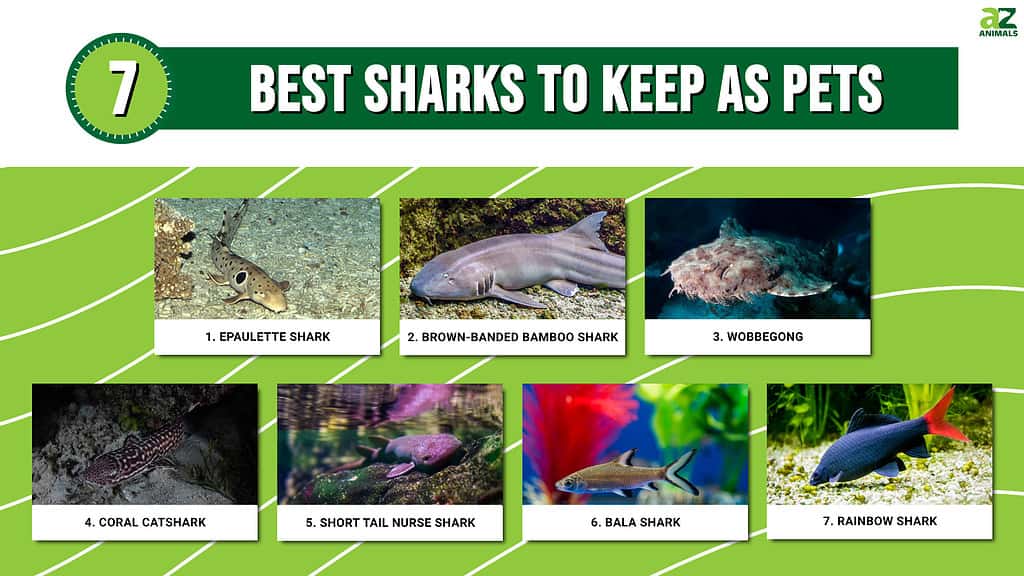
Here is a list of the best sharks (and a couple of fish that are similar to sharks) to keep as pets to spice up your tank!
1. Epaulette Shark (Emiscyllium ocellatum)
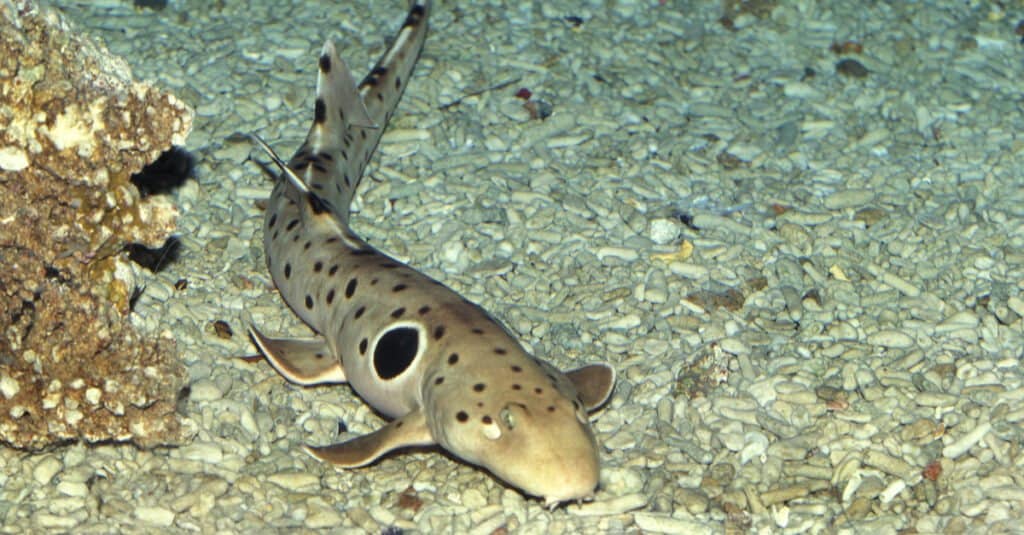
One of the most popular sharks to keep as pets is the epaulette shark!
©slowmotiongli/Shutterstock.com
The epaulette shark is a long, slender shark with a flattened head. This shark is the most popular shark to keep as a pet! Epaulette sharks have a unique appearance due to their spotted coloration. They have a base color of light brown and are covered in black spots, with more prominent spots on either side of their bodies. They are generally around 3.3 feet when fully matured.
Epaulette sharks also have a unique method of moving around. They use their pectoral and pelvic fins to essentially walk along the sea floor, in shallow waters, or even on land. This helps them immensely in their search for prey in the wild as they can navigate between different tide pools. And when it comes to personality, epaulette sharks have a peaceful temperament, which makes them easy to handle.
The epaulette shark has many qualities that make it suitable to keep as a pet. First, its size – compared to other sharks, epaulette sharks are small. But keep in mind that they still require aquariums of 180 gallons and over. Furthermore, providing these sharks with a suitable dry land area will help them feel at home.
Second, their diet – their diet consists of small invertebrates such as shrimp, crabs, and small fish, all of which are available at any aquarium store.
And finally, their behavior – because of their ability to walk, they make amazing centerpieces for any home and make good conversation starters. They are entertaining to watch and will provide you with up to 20 years of enjoyment. However, due to their long lifespan, it is important to think it through before adding one of these sharks to your family.
2. Brown-Banded Bamboo Shark (Chiloscyllium punctatum)
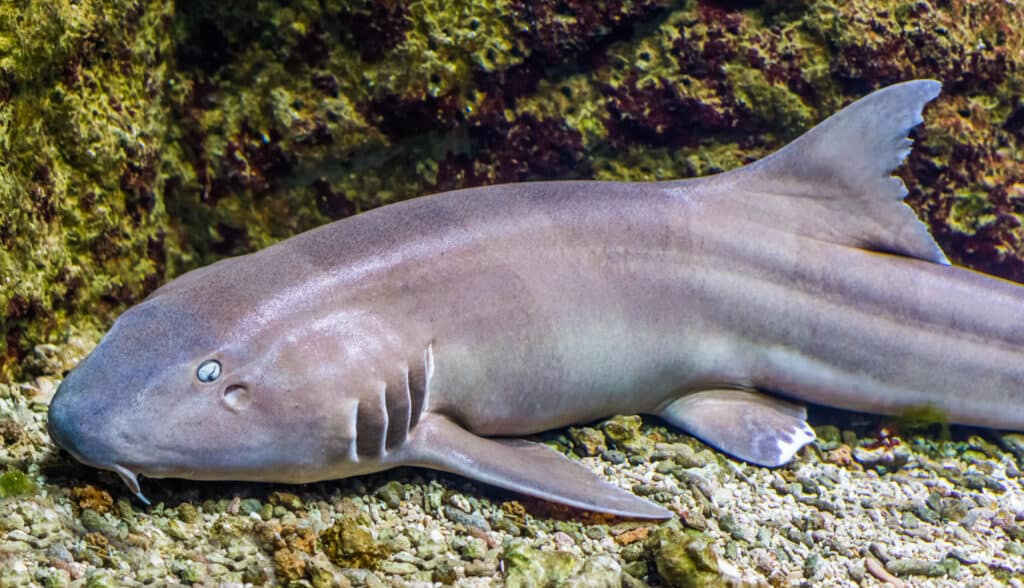
Growing a bit over 40 inches long, the brown-banded bamboo shark can make a great pet!
©Charlotte Bleijenberg/Shutterstock.com
The brown-banded bamboo shark is another awesome shark that can be kept as a pet! A distinguishing feature of this shark is the barbels around its nose. As the name suggests, the brown-banded bamboo shark has beautiful banded markings. However, unfortunately, these markings fade with maturity. Fully grown brown-banded sharks can grow a little over 40 inches (3.3 feet) long.
This shark is a carnivore and should be fed a meaty diet, including shrimp, scallops, squid, and other fish. Interestingly, these docile sharks do not compete well for food and may need to be “target fed” to ensure they eat properly to maintain their health.
Brown-banded bamboo sharks make excellent pets for those who desperately want a shark in their tank. Because of their size, these sharks can be kept in a 180-gallon tank with other compatible fish. They are nocturnal, and they require a cave where they can hide during the day. They also require a soft substrate as course textures can scratch the abdomen of the shark. With ideal conditions, these sharks can live around 20 to 25 years! With the care that goes into keeping these guys happy, the brown-banded bamboo shark is sure to impress!
3. Wobbegong (Orectolobidae)

Some species of wobbegong shark can be suitable for aquariums.
©frantisekhojdysz/Shutterstock.com
The wobbegong can be a perfect shark to keep as a pet as long as you get the right species. Some wobbegongs can grow up to 10 feet long, which would not be ideal for an aquarium, of course! Instead, the best species to get would be the northern wobbegong (O. wardi), also known as Ward’s wobbegong, as these are small sharks that grow to around just 2 feet long. This type of shark has a flat, stout body and a short, fringed mouth. The wobbegong is nicely camouflaged with markings that resemble a carpet. Because of this, it is also called a carpet shark.
The wobbegong’s diet mainly consists of bottom-dwelling fish, octopus, crabs, and lobsters. Wobbegongs are ambush predators and are mainly carnivorous. These sharks are also fairly low maintenance, as they only need to be fed twice a week!
These amazing fish can be kept in 135-gallon tanks, but they do tend to be happier in tanks that are 180 gallons or more. Be careful of putting other fish in the tank with the wobbegong, as these sharks will eat their tank mates. However, despite that, wobbegongs can make excellent pets; they do not move around much, and they spend most of their time at the bottom of their tank.
4. Coral Catshark (Atelomycterus marmoratus)
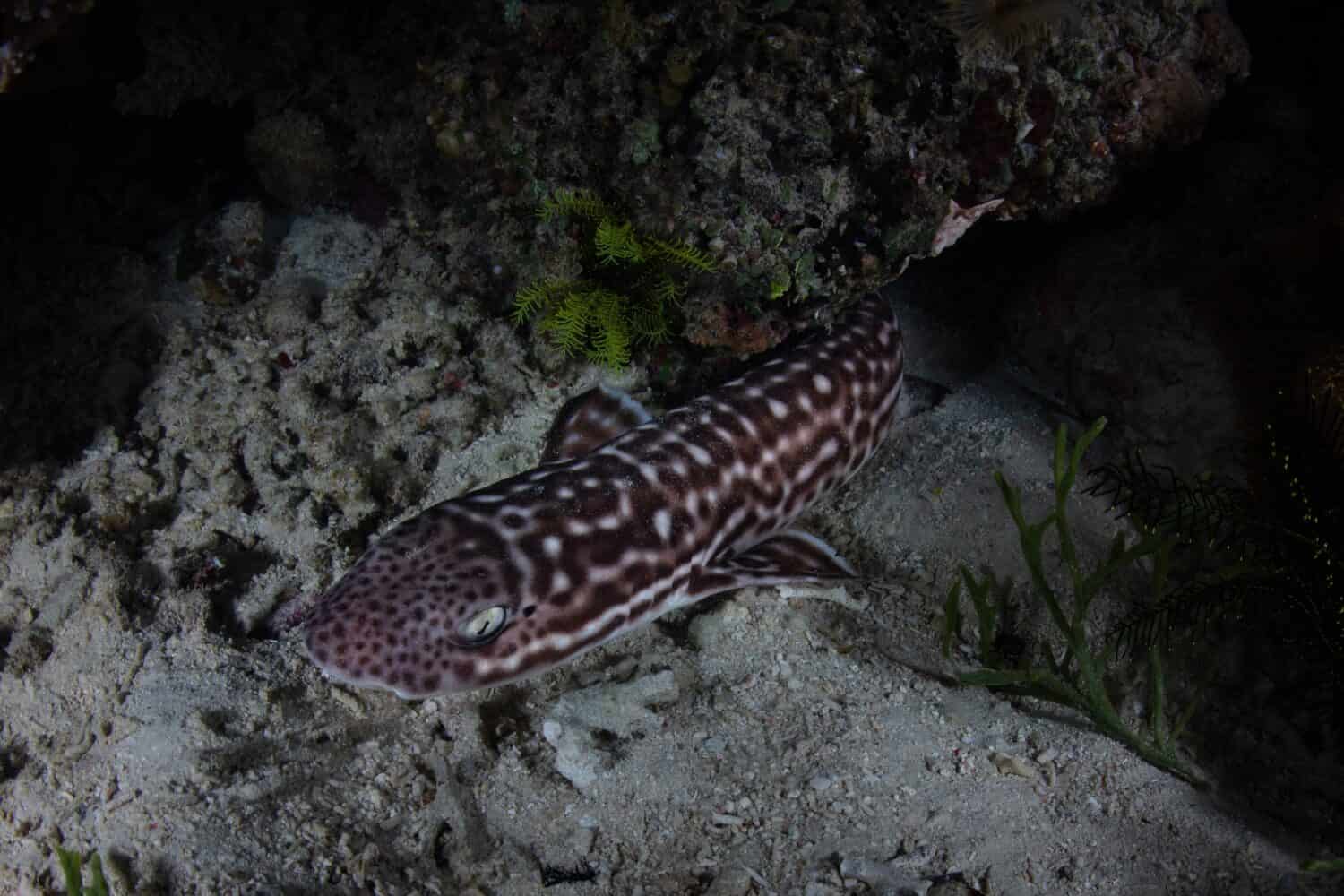
As evidenced by its name, coral catsharks live on coral reefs.
©Ethan Daniels/Shutterstock.com
The coral catshark is a species of catshark that lives on coral reefs. This type of shark can grow up to 28 inches in length, making it small enough to keep as a pet! Its body is extremely slender, while its head and tail are short. The most identifying feature of the coral catshark is the numerous black and white spots on its back, sides, and fins. On the other hand, the underside of the coral catshark is white in color.
The coral catshark is active during dusk and at night. When active, this shark will forage for bottom-dwelling invertebrates and small bony fish. In a tank, the coral catshark will adjust very quickly to eating silver sides, clams, shrimp, mussels, fish flesh, and more.
The beautiful coral catsharks make excellent pets due to their size, rarity, and appearance. For these sharks to thrive, they will need a 300 to 450-gallon tank, with a 450-gallon tank being optimal. They can be kept with other tropical fish species that are not aggressive. However, if these sharks are not fed well, they may consume the invertebrates or small fish species that live with them. Coral catsharks also require open areas for swimming and caves to seek shelter in. Like all other shark species, these sharks require excellent water conditions in order to thrive.
5. Short Tail Nurse Shark (Pseudoginglymostoma brevicaudatum)
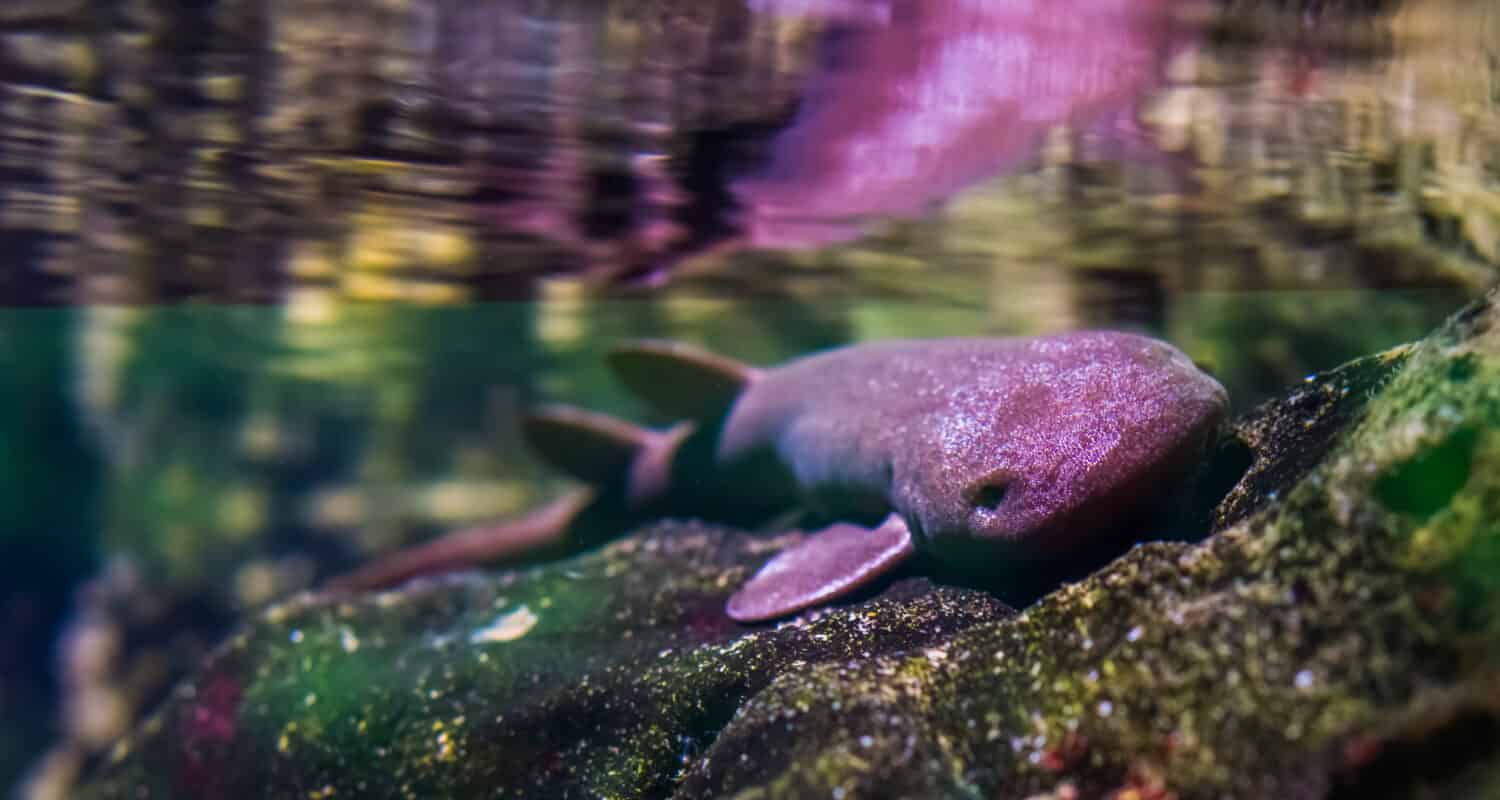
Due to their size and low activity, short-tail
nurse sharks
make great pets.
©Charlotte Bleijenberg/Shutterstock.com
The short-tail nurse shark is the smallest member of the nurse shark family. These sharks are tropical reef species that can grow up to 30 inches long. As the name suggests, short-tail nurse sharks have short tails. They also have a broad head that is quite blunt with tiny nasal barbels.
These cute sharks need a diet that consists of fresh fish, squid or shrimp, scallops, and clams. Luckily, these can all be found at any grocery seafood department.
Short-tail nurse sharks make great pets because of their size and relatively low activity. However, make sure your tank is at least 200 gallons. Furthermore, water conditions must be pristine, and you must choose their tankmates carefully to ensure long-term success. These sharks will typically sit on the bottom of the tank or in caves during the day as they are nocturnal. If they are seen active during the day, it may indicate a need for more frequent feeding.
Because of the care the short-tail nurse shark requires, they are considered an “expert only” animal. Make sure that you can give these sharks a great life before taking one on! A happy short-tail nurse shark can live over 25 years.
6. Bala Shark (Balantiocheilos melanopterus)
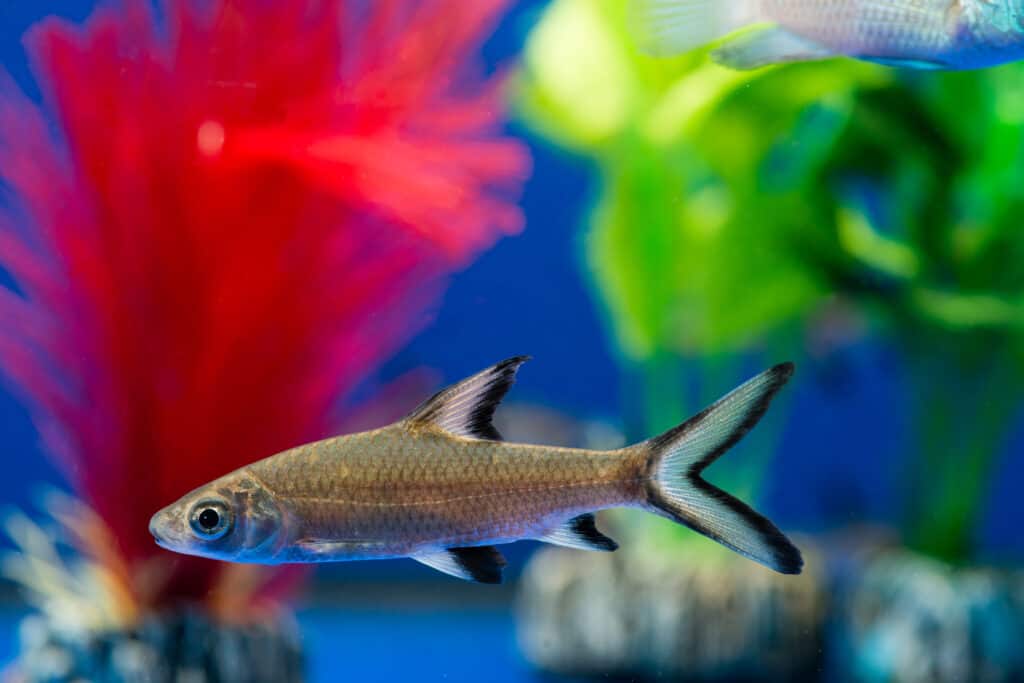
While not technically a shark, a bala shark definitely looks like one!
©smspsy/Shutterstock.com
The bala shark is a freshwater fish that closely resembles a shark. The bala shark’s color, shape, and mouth give this fish a shark-like appearance. However, in reality, the bala shark is related to the carp family and is not a true shark, despite its name. The bala shark has earned the name “shark” thanks to the way it swims. Its body is silver in color, its fins are black, and there are yellow patches scattered across the body. A healthy bala shark can grow up to 12 inches long.
The bala shark loves swimming and requires a large tank and plenty of food. This fish is an omnivore and will eat a variety of foods, including live food, frozen food, pellets, and flakes. In freshwater environments, this fish will feed on crustaceans, plants, insects, and larvae. Interestingly, the bala shark does not chew or bite their food. Instead, this fish sucks in its food through its open mouth.
Bala sharks are schooling fish and do best when there are at least three in the tank. These fish also get along with other species of peaceful fish. As with the other fish on this list, bala sharks will require resting places inside the aquarium. The optimum size tank for the bala shark is between a 120 and 150-gallon tank. This will ensure that these fish have enough space for swimming.
Bala sharks make amazing pets and are great additions to a large aquarium. These beautiful fish can live for around 10 years in an ideal environment.
7. Rainbow Shark (Epalzeorhynchos frenatum)
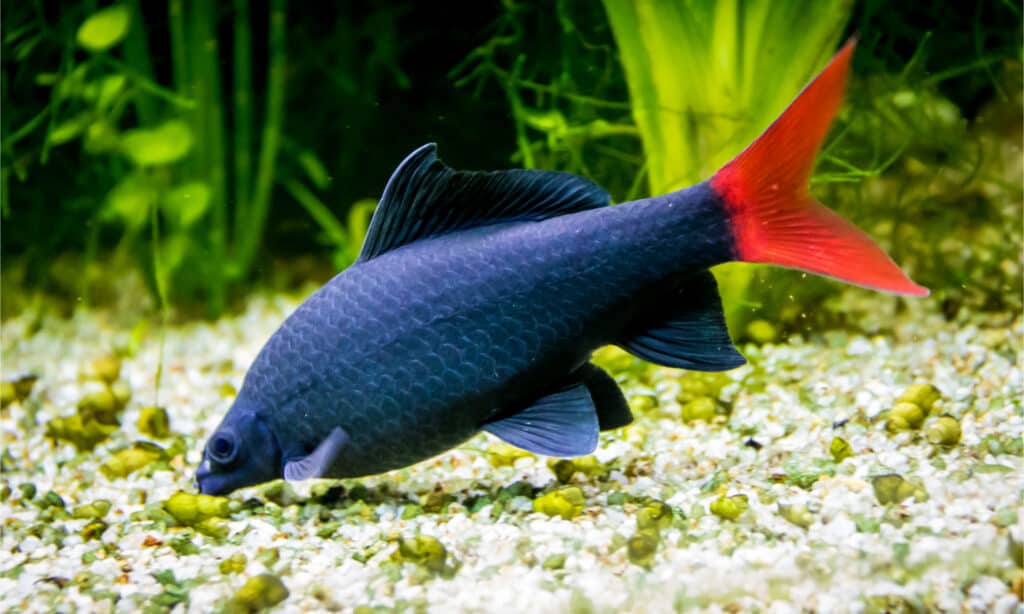
The rainbow shark, although not a true shark, has a long body, a pointed snout, and a forked tail.
©iStock.com/diegograndi
Like the bala shark, the rainbow shark is not a true shark. Instead, it is a small, bony ray-finned fish, closely related to carp and minnow species. The rainbow shark is also commonly known by different names, including ruby shark, red-fin shark, and rainbow shark minnow. The reason this fish is called a shark is due to the shape of the body and dorsal fin resembling a shark. The rainbow shark has a long body, a pointed snout, and a forked tail – just like a shark! This beautiful fish also has unusual color combinations. The body can be black, blue, gray, or albino, while the fins are bright orange or red. In terms of size, the rainbow shark is quite tiny, growing up to just 6 inches long.
Rainbow sharks are omnivorous and consume a variety of food that float down to the bottom of the river. They consume algae, larvae, insects, plankton, crustaceans, and more. In captivity, these fish will eat algae tablets, insect larvae, bloodworms, brine shrimp, and even vegetables. To help with their bright coloration, make sure to feed rainbow sharks a high-protein diet.
Although these fish would look great in your aquarium, be aware that they do not get along with other fish. However, the rainbow shark should be able to coexist with other peaceful freshwater tank fish as long as they do not occupy the same water layer as the rainbow shark. Avoid timid fish, such as catfish, as the rainbow shark may chase and attack those fish. Finally, although rainbow sharks can be kept together, they can be aggressive toward each other. Furthermore, tank size is especially important, as each rainbow shark will need at least a 50-gallon tank.
Summary of the 7 Best Sharks to Keep as Pets
Shark | Scientific Name | |
|---|---|---|
| 1 | Epaulette | Emiscyllium ocellatum |
| 2 | Grey Bamboo Shark | Chiloscyllium griseum |
| 3 | Wobbegong | Orectolobidae |
| 4 | Coral Catshark | Atelomycterus marmoratus |
| 5 | Short Tail Nurse Shark | Pseudoginglymostoma brevicaudatum |
| 6 | Bala Shark | Balantiocheilos melanopterus |
| 7 | Rainbow Shark | Epalzeorhynchos frenatum |
The photo featured at the top of this post is © Charlotte Bleijenberg/Shutterstock.com
Thank you for reading! Have some feedback for us? Contact the AZ Animals editorial team.






